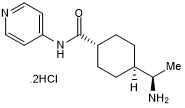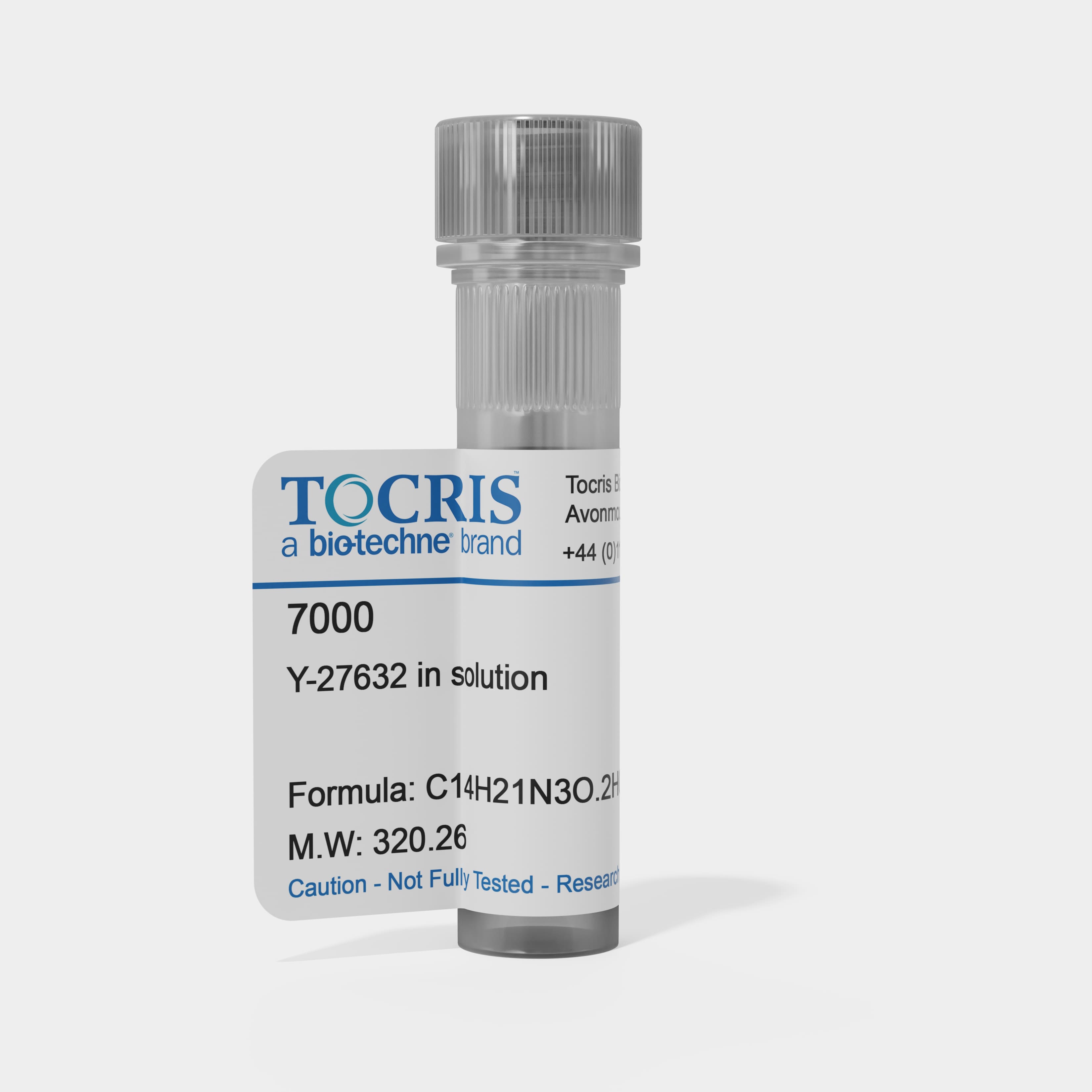Rho-kinase Inhibitors Products
Rho-kinases, also known as Rho-associated coiled-coil kinases or ROCK inhibitors (ROCK), are serine/threonine kinases named for their activation by RhoA GTPases. These enzymes play a role as regulators of cytoskeletal rearrangement, including the formation of focal adhesions, cell motility, and the invasion of tumor cells. ROCK inhibitors such as Y-27632 are used in stem cell research protocols, including cell proliferation and differentiation.
There are two isoforms of Rho-kinase, namely ROCK1 (also known as ROKβ or p160 ROCK) and ROCK2 (also known as ROKα). These isoforms exhibit a significant structural similarity in their kinase domains (92%). Despite this similarity, they differ in their tissue expression patterns; ROCK2 is prominently expressed in the brain and muscle, while ROCK1 is distributed widely across various tissues. Subcellularly, ROCK2 is located in the cytosol and relocates to the cleavage furrow during cytokinesis. In contrast, ROCK1 is thought to co-localize with centrosomes, playing a crucial role in cell cycle regulation.
13 results for "Rho-kinase Inhibitors" in Products
13 results for "Rho-kinase Inhibitors" in Products
Rho-kinase Inhibitors Products
Rho-kinases, also known as Rho-associated coiled-coil kinases or ROCK inhibitors (ROCK), are serine/threonine kinases named for their activation by RhoA GTPases. These enzymes play a role as regulators of cytoskeletal rearrangement, including the formation of focal adhesions, cell motility, and the invasion of tumor cells. ROCK inhibitors such as Y-27632 are used in stem cell research protocols, including cell proliferation and differentiation.
There are two isoforms of Rho-kinase, namely ROCK1 (also known as ROKβ or p160 ROCK) and ROCK2 (also known as ROKα). These isoforms exhibit a significant structural similarity in their kinase domains (92%). Despite this similarity, they differ in their tissue expression patterns; ROCK2 is prominently expressed in the brain and muscle, while ROCK1 is distributed widely across various tissues. Subcellularly, ROCK2 is located in the cytosol and relocates to the cleavage furrow during cytokinesis. In contrast, ROCK1 is thought to co-localize with centrosomes, playing a crucial role in cell cycle regulation.
Selective ROCK inhibitor; inhibits ROCK1 (p160 ROCK) and ROCK2; stem cell freezing (cryopreservation) media component
| Alternate Names: | y27632,Y-27632 2HCl,ROCK inhibitor,ROCK1 inhibitor |
| Chemical Name: | trans-4-[(1R)-1-Aminoethyl]-N-4-pyridinylcyclohexanecarboxamide dihydrochloride |
| Purity: | ≥98% (HPLC) |
Y-27632 synthesized to cGMP guidelines
| Chemical Name: | trans-4-[(1R)-1-Aminoethyl]-N-4-pyridinylcyclohexanecarboxamide dihydrochloride |
| Purity: | ≥99% |
Selective Rho-kinase (ROCK) inhibitor
| Chemical Name: | (S)-(+)-2-Methyl-1-[(4-methyl-5-isoquinolinyl)sulfonyl]-hexahydro-1H-1,4-diazepine dihydrochloride |
| Purity: | ≥98% (HPLC) |
Highly potent and selective ROCK 2 inhibitor; improves cell survival after cryogenesis
| Chemical Name: | (3S)-N-[2-[2-(Dimethylamino)ethoxy]-4-(1H-pyrazol-4-yl)phenyl]-3,4-dihydro-6-methoxy-2H-1-benzopyran-3-carboxamide dihydrochloride |
| Purity: | ≥98% (HPLC) |
Inhibitor of cyclic nucleotide dependent- and Rho-kinases
| Alternate Names: | HA 1077 |
| Purity: | ≥98% (HPLC) |
Sterile-filtered 10 mM solution of Y-27632 pre-dissolved in water
| Chemical Name: | trans-4-[(1R)-1-Aminoethyl]-N-4-pyridinylcyclohexanecarboxamide dihydrochloride |
| Purity: | ≥97% (HPLC) |
Potent, selective Rho-kinase (ROCK) inhibitor
| Chemical Name: | N-[2-[2-(Dimethylamino)ethoxy]-4-(1H-pyrazol-4-yl)phenyl-2,3-dihydro-1,4-benzodioxin-2-carboxamide dihydrochloride |
| Purity: | ≥98% (HPLC) |
Potent and highly selective ROCK inhibitor; orally active
| Alternate Names: | Azaindole-1,BAY-549 |
| Chemical Name: | 6-Chloro-N4-[3,5-difluoro-4-[(3-methyl-1H-pyrrolo[2,3-b]pyridin-4-yl)oxy]phenyl]-2,4-pyrimidinediamine |
| Purity: | ≥98% (HPLC) |
Potent and selective ROCK inhibitor
| Chemical Name: | N-[3-[[2-(4-Amino-1,2,5-oxadiazol-3-yl)-1-ethyl-1H-imidazo[4,5-c]pyridin-6-yl]oxy]phenyl]-4-[2-(4-morpholinyl)ethoxy]benzamide |
| Purity: | ≥99% (HPLC) |
Potent ROCK inhibitor
| Chemical Name: | 2-Fluoro-N-[[4-(1H-pyrrolo[2,3-b]pyridin-4-yl)phenyl]methyl]benzenemethanamine dihydrochloride |
| Purity: | ≥98% (HPLC) |
Potent and selective ROCK inhibitor; antitumor
| Chemical Name: | N-[(3-Hydroxyphenyl)methyl]-N'-[4-(4-pyridinyl)-2-thiazolyl]urea dihydrochloride |
| Purity: | ≥99% (HPLC) |
Potent Rho-kinase inhibitor; vasodilator
| Chemical Name: | (3S)-1-[[2-(4-Amino-1,2,5-oxadiazol-3-yl)-1-ethyl-1H-imidazo[4,5-c]pyridin-7-yl]carbonyl]-3-pyrrolidinamine dihydrochloride |
| Purity: | ≥99% (HPLC) |
Selective Rho-kinase (ROCK) inhibitor. More selective analog of H 1152 dihydrochloride (Cat. No. 2414)
| Chemical Name: | (S)-(+)-4-Glycyl-2-methyl-1-[(4-methyl-5-isoquinolinyl)sulfonyl]-hexahydro-1H-1,4-diazepine dihydrochloride |
| Purity: | ≥99% (HPLC) |













